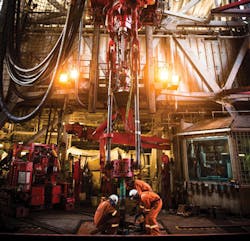Statoil maintains its drilling momentum
At a time when many campaigns are being reduced or suspended, Statoil is ramping up its drilling program in the Norwegian, North, and Barents seas, as well as in the US Gulf of Mexico and a number of frontier areas.
In early January, the company announced plans to drill about 30 exploration wells in 2017, around 30% more than last year, with more than half (16-18) targeting prospects offshore Norway.
Tim Dodson, executive vice president for exploration, said the program would be balanced between proven, well-known basins, and new frontier opportunities. However, drilling plans remain contingent on permitting, rig availability, and partner approvals.
Last year, Statoil completed 23 exploration wells as operator and partner, including 14 offshore Norway. This program and associated licensing and seismic data acquisition came in below the originally forecast budget, due to efficiency improvements and favorable market conditions.
This year’s line-up includes five to seven exploration wells in the Barents Sea. Others in the Norwegian Sea and North Sea are designed to prove additional near-field volumes in order to prolong the productive lifetime of existing infrastructure and determine growth potential.
Targeted structures in the Barents Sea are in well-known plays in the Johan Castberg and Hoop/Wisting area, and frontier areas with greater geological uncertainty but also high impact potential.
“Following our take-over as operator for the Carcará discovery last summer,” Dodson added, “Brazil has become even more important in Statoil’s portfolio, not least on the exploration front. We are stepping up exploration also in the UK, with plans for three Statoil-operated exploration wells in 2017.”
Elsewhere, the company will participate in wells planned in established basins such as the US Gulf of Mexico and in emerging frontier areas offshore Indonesia and Suriname.
On the heels of this announcement, Statoil reported that it had made a new oil and gas discovery close to the Norne field in the Norwegian Sea. The new discovery, made with the Cape Vulture exploration well, has been initially estimated at between 20 and 80 MMboe of recoverable reserves. “It’s great kicking off the new year with a discovery,” said Jez Averty, senior vice president for exploration in Norway and the UK.
The drilling of the Cape Vulture exploration well began in early December 2016. The well was drilled in the license 128 as a result of the award of license 128D in the Award in Predefined Areas round in 2015. The drilling of the well is the result of the development of a new exploration concept for the Nordland Ridge.
“We make this discovery one year after the announcement of the licence award at the 2016 Sandefjord conference,” Averty added. “We are satisfied with already completing the well and happy to be able to announce Cape Vulture as a commercial discovery. This shows the importance of new acreage, demonstrates our ability to quickly test new opportunities, and emphasizes that looking at mature areas in new ways may pay off.”
Statoil officials say that the Cape Vulture discovery opens up for further exploration opportunities in the area. The company says that it will now analyze the results in detail, and identify any new exploration targets in the area. Located northwest of Norne, a tieback of the discovery to the FPSO at the Norne field will be considered.
“We are very pleased with this discovery”, says Siri Kindem, Statoil’s senior vice president for Operations North. “Norne is already a much greater success than we expected when the field was discovered. It has been the backbone of our ventures in the north from the very beginning and discoveries such Cape Vulture contribute to Norne’s long life, and to maintaining activities in the Norwegian Sea.” Kindem noted that Statoil has a 40-year presence in the north, and added that Statoil “continue[s] to be the driving force in the oil and gas industry here.”
Statoil is the operator of license 128 and 128D with a 64% share. Petoro holds a 24.5% share and Eni holds a 11.5% share.
Originally discovered in 1992, first oil was produced from the Norne field in 1997. Its productive life was originally planned to last until 2014, but the field has been further developed with additional resources. Statoil’s current goal is to maintain operations at Norne until 2030.
Then, in mid-January, Statoil awarded service contracts to Baker Hughes and Schlumberger to provide integrated drilling and well services on the Cat J jackup drilling rigsAskepott and Askeladden. The rigs will start work this summer and fall at the Oseberg and Gullfaks field centers. Under the initial four-year terms, the contractors’ responsibilities will include provision of cementing and pumping, services, and of drilling and completion fluids.



